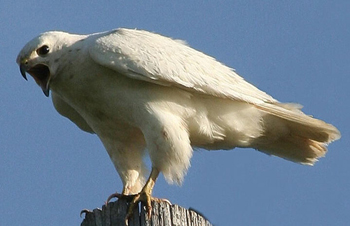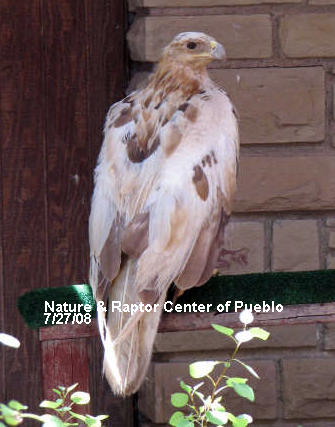
The bright, white object ranchers discovered in a field in southeastern Colorado last July fell from the sky and may be the only one of its kind.
It is neither a meteorite nor an extraterrestrial--although it has attracted attention on par with these unearthly items--but a bird, one partially albino golden eagle. By the time the raptor reached Diana Miller, who directs the , in Pueblo, Colo., it was near death.
âHis feathers were in terrible condition,â said Miller. âHe had a soft tissue injury to the left shoulder, and a very heavy load of ectoparasites, both the chewing lice and the sucking lice.â (Chewing lice eat feathers; sucking lice eat skin).

A partially albino red-tailed hawk. About one in every 1,800 birds exhibit albinism, according to an ÃÛèÖAPP bird book. (By Allan Whiteman)
Partially albino, or leukistic, birds are rare, occurring in about one in every 1,800 individuals, according to the . Their catchy coats are the result of a recessive gene that reduces the production of melanin, a pigment which gives feathers color and strength. Without it, feathers fray and fall out; the wings on the eagle Miller received were worn down to the shafts. With weakened wings and a susceptibility to sunburn, predators and parasite attacks, leukistic raptors usually donât live long.
Leukistic and albino songbirds exist too (), but with more predators than raptors their chances of survival are even slimmer. Completely albino birds are rarer yet. While partially albino birds have color on their beaks and in their eyes, true albinos have none; their eyes are pink or redâwithout pigment, blood gives the iris its color. True albinos are less likely to survive, but wowed by whiteness few people see their sickness.
âEveryone and their brother want to come see a white bird,â said John Karger, who runs , a bird of prey conservancy in San Antonio, Texas. âPeople think thatâs the cha-ching.â
Albino tigers and gorillas bolster attendance at zoos and albino snakes and parrots fetch fat prices, but Karger doesnât see cash in albinos; he sees sadness.
A leukistic red-tailed hawk he received years ago attracted hoards of visitors--but also diseases. âThe bird was very thin and had internal and external parasites that were devouring him,â said Karger.
He fed the hawk nutrients and administered medicine for worms and parasites. âHe popped out of it,â said Karger, âbut not a year went by when he wasnât in with the vet.â The hawk died of a common fungal infection that rarely kills, and Karger now questions whether he should have kept it alive so long. He is baffled by the publicâs obsession with albino animals. âItâs sort of like dragging a malformed person out of a geek show,â Karger said.

Susceptibility to sunburn, predators and parasite attacks means partially albino raptors usually donât live long. (Courtesy of Eddie Horvath)
But for many people, sighting an albino or partially albino bird is inspiring and unforgettable.
Eddie Horvath, a Utah falconer, runs a that documents albino and leukistic raptor sightings. People have posted from Monroe, Mich., Knox, N.Y and Lone Oak, Texas.
One entry, from a woman in Sanford, Fla., reads: âWe have recently moved into a new housing development which only has about eight residents. On the morning of January 15, 2006, at 7:15 a.m., we saw an albino or white raptor sail out of the old oak trees to the ground to feed on something. The whiteness and wing span was awesome. Having no camera handy, we did not get a picture, but the thrill of seeing such a rare bird was tremendous.â
For Miller, the experience of handling a partially albino golden eagle, perhaps the only ever treated in a facility, has been tremendous as well.
âHeâs amazing,â she said. âYou canât help but go, âWoah, youâre a freak but youâre gorgeous.ââ
The bird is back on a diet of rats and rabbits and has a new roommate, a female golden eagle recovering from a run-in with barbed wire, but Miller is still unsure when it will be set free.
âItâs a tough one for a rehabber,â she said. âIâm always torn because we can probably strengthen him until he can hunt and kill for himself, but I am told by the experts that he will probably fade back out.â

"The whiteness and wing span was awesome," said a Sanford, Fla. woman upon seeing an albino raptor in her yard. (By Allan Whiteman)
The Nature and Raptor Center of Pueblo has set up a to view the eagle. John Karger will be displaying his birds of prey to the in San Antonio, Texas on Thursday, November 13 at 6 p.m. in the Brazier Room of Los Patios Restaurant. For a list of activities at the Nature and Raptor Center in Pueblo, Colo., .
 \
\
The leukistic golden eagle at the Nature and Raptor Center of Pueblo is believed to be the only one of its kind. (Courtesy of Diana Miller)
